The principal impetus behind lens form selection is optical performance. Base curves are typically chosen to provide a wide field of clear vision. It turns out that the form of a lens will have a significant impact on the clarity of peripheral vision experienced by the wearer. Although vision through the center of a lens will be relatively sharp no matter what the form, vision through the periphery of a lens will vary greatly as a function of lens form.
Peripheral vision generally requires the wearer to look away from the optical center of the lens. As a result, the wearer's line of sight makes an angle to optical axis of the lens, which is the imaginary line passing through the optical center. Consequently, we often refer to the peripheral performance of a spectacle lens as its off-axis or off-center performance. During peripheral and dynamic vision, the line of sight makes an angle to the optical axis of up to 30° or more as the wearer observes objects in the visual field.
The focal power formula, P = F + B, adequately describes the behavior of the lens near its optical center, within an area referred to as the paraxial region, since incident rays of light make very small angles to its optical axis. These small angles result in a well-behaved refraction of the incident light rays, allowing us to simplify Snell's law of refraction using a mathematical simplification known as a first-order approximation. Light rays refracted through the paraxial region will form a sharp point focus at the desired focal point of the lens and ultimately upon the retina of the eye.
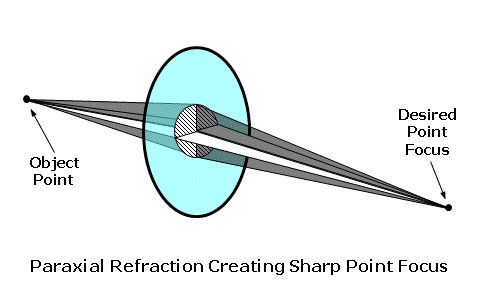
However, away from the paraxial region, the incident rays of light make larger and larger angles to the optical axis, and the first-order approximation no longer accurately describes the refraction of light rays. Incident rays of light are no longer brought to a single point focus at the desired focal point of the lens, as described by our simple focal power formula. This error in focus is referred to as a lens aberration.
Lens aberrations act as errors in power from the desired prescription, and can degrade the image quality produced by the lens as the wearer gazes away from—or obliquely to—its optical axis. There are six different lens aberrations that can affect the quality of peripheral vision through a spectacle lens:
- Oblique Astigmatism
- Power Error
- Spherical Aberration
- Coma
- Distortion
- Chromatic Aberration
The first five lens aberrations are referred to as the monochromatic aberrations, since they occur independently of color. They are also referred to as the Seidel aberrations, since Ludwig Von Seidel first derived equations for assessing these aberrations using a third-order approximation (which is more accurate than the first-order approximation).
We will concentrate mainly on oblique astigmatism and power error, which are the two primary lens aberrations that must be reduced or eliminated when designing ophthalmic lenses.
The sixth lens aberration, chromatic aberration, is a consequence of the dispersive properties of the actual lens material, and is not a function of lens design.
You can also think of a lens aberration as the failure of a lens, which has otherwise been made correctly, to produce a sharp focus at the desired focal point of the lens as the eye rotates behind it in order to view objects in the periphery. The focal power of the lens is prescribed to produce a focus at the far-point of the eye. The far-point (FP) of the eye is conjugate to the retina, meaning that rays of light from a lens that come to a focus at the far-point will also be brought to a focus at the retina once refracted by the eye. Hence, the far-point represents the ideal focal plane of the spectacle lens.
As the eye rotates vertically and horizontally behind the lens, the far-point moves with the eye at a fixed distance from its center of rotation (C). This movement describes an imaginary spherical surface, known as the far-point sphere, which represents the ideal locus of focal points for the lens as the eye rotates to look through it. Lens aberrations result when light refracted by a lens fails to come to a focus at the far-point sphere.
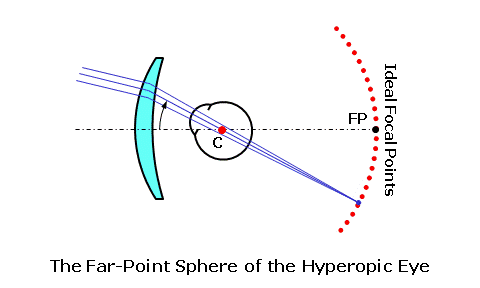
Tangential and Sagittal Errors
In our discussion of lens aberrations, we will often refer to the tangential and sagittal errors from the desired power. The tangential plane of the lens represents the meridian of the lens that radiates out from the optical center; these planes are analogous to the spokes of a bicycle wheel. The sagittal plane of the lens represents the meridian of the lens that is perpendicular to the tangential plane (i.e., at a 90° angle to it) at any point; these planes circumscribe the optical center.
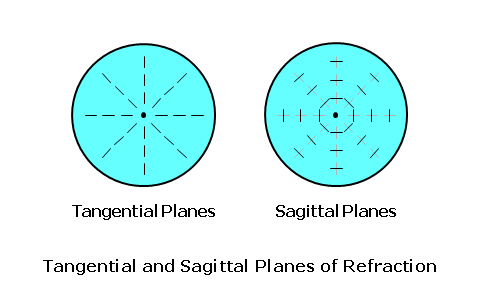
When rays of light from an object strike the lens obliquely, the principal refraction of these rays occurs through the tangential and sagittal meridians, much like the principal refraction of a sphero-cylindrical lens occurs through its principal power meridians. The tangential error is the error from the desired focus through the tangential meridian of the lens as a result of lens aberrations. The sagittal error is the error from the desired focus through the sagittal meridian of the lens.
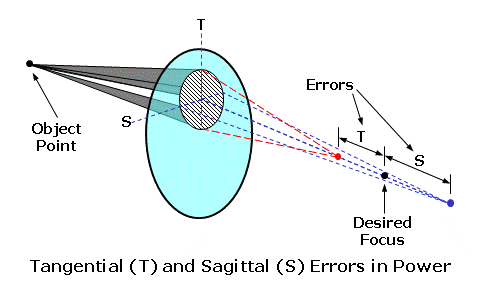
Oblique Astigmatism
Oblique astigmatism is an aberration that results when rays of light from an object in the periphery strike the lens obliquely, and are refracted differently by the tangential and sagittal meridians of the lens. When a lens suffers from oblique astigmatism, the tangential meridian (T) of the lens refracts incident light more than the sagittal meridian (S) perpendicular to it. Consequently, incident light from an off-axis object point is brought to a focus at two different locations (i.e., the tangential focus and the sagittal focus). The image of the object point is no longer focused to a single point, but rather separated into two focal lines instead.
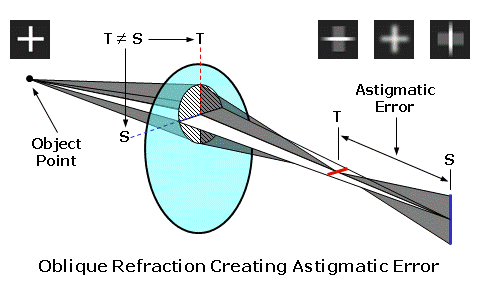
Note that two focal lines are produced from each single object point by the tangential and sagittal meridians of the lens, instead of a single point focus. The dioptric difference between these two focal lines is known as the astigmatic error of the lens. Oblique astigmatism is similar to the normal ocular astigmatism for which refractionists prescribe cylinder power. However, oblique astigmatism only occurs when the wearer looks through the lens at an angle (hence, "oblique") or through the peripheral regions of the lens. Since it is an astigmatic focusing error, this error is similar in effect to unwanted cylinder power in a prescription.
When light is incident upon a surface at an angle, it produces such an astigmatic focus. Since light is refracted by two surfaces as it passes through a lens, the total oblique astigmatism produced by the lens depends upon the net astigmatism produced at each surface. Consequently, oblique astigmatism is dependent upon the form of the lens—that is, the relationship between the front and back curves. Certain lens forms will produce more oblique astigmatism than others.
In terms of our tangential and sagittal errors, the astigmatic error is given by:
Astigmatic Error = Tangential Error - Sagittal Error
In addition to the oblique astigmatism that occurs while viewing off-axis objects in the periphery, you can introduce oblique astigmatism by simply tilting a lens, since this also places the line of sight at a significant angle to the optical axis of the lens. This is sometimes referred to as "astigmatism due to lens tilt." The oblique astigmatism induced by lens tilt can be minimized by ensuring that the optical axis of the lens passes through the center of rotation (C) of the eye. We can accomplish this by manipulating the relationship between the pantoscopic tilt—which is lens tilt toward the cheeks—and the height (H) of the wearer's pupil center above the optical center (OC) of the lens according to the following rule-of-thumb:
Ensure 1 mm of Optical Center Drop (H) for Every 2° of Pantoscopic Tilt
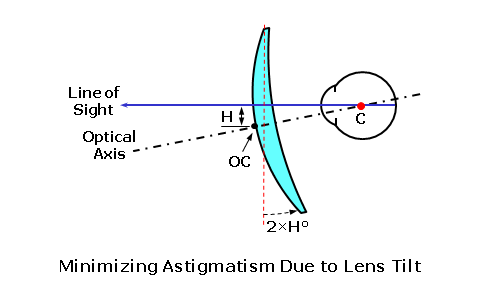
Power Error
In the absence of oblique astigmatism, a spectacle lens brings light to a focus across a curved image plane referred to as the Petzval surface. Curvature of the field is an aberration that results from the difference in focus between a flat focal plane and the curved collection of actual focal points on the Petzval surface. This aberration is a concern for optical devices that require a flat image plane, such as cameras. However, recall that the ideal image plane of the eye, the far-point sphere, is also curved. Unfortunately, the Petzval surface is generally flatter than the far-point sphere. Power error is an aberration that results from the difference in focus between the Petzval surface (PS) and the far-point sphere (FPS) of the eye.
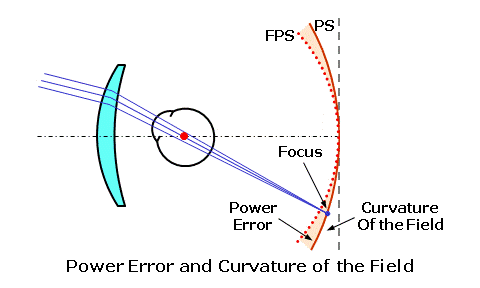
Power error is a result of the fact that the focal plane of the lens for off-axis object points departs from the far-point sphere of the eye, even when the lens is free from oblique astigmatism. In the presence of power error, light from an object point may be refracted to a single point focus by the tangential (T) and sagittal (S) meridians, but this point focus does not lie on the far-point sphere (FPS). The dioptric difference between the actual focal point of the lens and its desired focal point is the power error of the lens. Power error is a spherical-like focusing error, and is similar in effect to unwanted sphere power in a prescription. This is in contrast to the astigmatic error produced by oblique astigmatism.
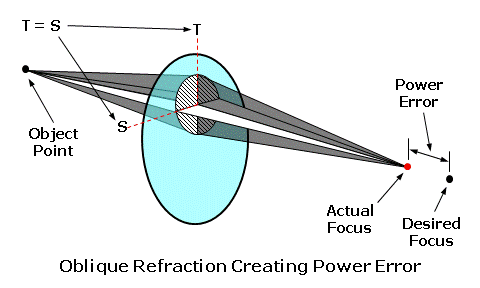
In the presence of oblique astigmatism, there is no single focal point but rather two focal lines. In this case, the power error is equal to the average dioptric difference between the two astigmatic focal lines and the desired focal point of the lens, just as the spherical equivalent is equal to the average power of a sphero-cylindrical prescription.
In terms of our tangential and sagittal errors, the power error is given by:
Power Error = (Tangential Error + Sagittal Error) ÷ 2
For example, consider a +4.00 D lens that produces a power of +5.00 D through the tangential meridian and a power of +4.50 D through the sagittal meridian at some distance from the optical center. This represents a tangential error of 5.00 - 4.00 = +1.00 D and a sagittal error of 4.50 - 4.00 = +0.50 D. The astigmatic error is equal to 1.00 - 0.50 = 0.50 D, while the power error is equal to (1.00 + 0.50) / 2 = +0.75 D.













